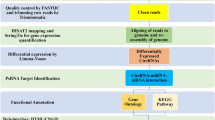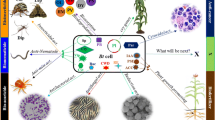Abstract
Background
Chlorantraniliprole is a diamide insecticide widely used in China over the last 15 years. The fall armyworm (FAW), Spodoptera frugiperda, newly invaded China in 2019. The response of FAW to chlorantraniliprole deserves more attention, in the context of many destructive lepidopteran species are resistant to diamide insecticides and the patent on core chemical of chlorantraniliprole in China expired in August 2022.
Methods and results
This study investigated the response profile in larvae under chlorantraniliprole-induced (LC50) stress using methods of bioassay, RNA-Seq and qPCR. We observed growth inhibition and lethal effects in FAW larvae, but at a relatively high LC50 value compared to other several pests. Additionally, under chlorantraniliprole-induced stress, 3309 unigenes were found to be differentially expressed genes. The impacted genes included 137 encoding for detoxification enzymes, 29 encoding for cuticle proteins, and 20 key enzymes involved in the chitin metabolism, which all associated with metabolic resistance. Finally, we obtained the single nucleotide polymorphisms (SNPs) of two RyR genes, which are the target proteins for chlorantraniliprole. We also investigated the causes of the high LC50 value in our FAW, which possibly related to the stabilized 4743 M on SNP frequency of RyR. These findings documented the genetic background of RyR of FAW and indicated that application of chlorantraniliprole has a high risk of controlling FAW in China.
Conclusion
In brief, our results provide a better understanding of the mechanisms of chlorantraniliprole toxicity and detoxification in FAW, and will aid in monitoring the development of resistant strains for a newly pest to an old insecticide.





Similar content being viewed by others
Data availability
The six datasets generated and analyzed during the current study are available in the NCBI SRA database with the accession number of SRA: SRS15030502, SRS15030503, SRS15030520 (chlorantraniliprole-induced groups), and the accession number of SRA:SRS15030504, SRS15030505, SRS15030506 (control groups) (https://www.ncbi.nlm.nih.gov/bioproject/?term=PRJNA877689).
References
Wang R, Jiang C, Guo X, Chen D, You C, Zhang Y et al (2019) Potential distribution of Spodoptera frugiperda (J.E. Smith) in China and the major factors influencing distribution. Global Ecol Conserv 21:e00865. https://doi.org/10.1016/j.gecco.2021.e01994
Sattelle DB, Cordova D, Cheek TR (2008) Insect ryanodine receptors: molecular targets for novel pest control chemicals. Invert Neurosci 8(3):107–119. https://doi.org/10.1007/s10158-008-0076-4
Richardson EB, Troczka BJ, Gutbrod O, Davies TGE, Nauen R (2020) Diamide resistance: 10 years of lessons from lepidopteran pests. J Pest Sci 93:911–928. https://doi.org/10.1007/s10340-020-01220-y
Su JY, Lai T, Li J (2012) Susceptibility of field populations of Spodoptera litura (Fabricius) (Lepidoptera: Noctuidae) in China to chlorantraniliprole and the activities of detoxification enzymes. Crop Prot 42:217–222. https://doi.org/10.1016/j.cropro.2012.06.012
Adams A, Gore J, Catchot A, Musser F, Cook D, Krishnan N (2016) Susceptibility of Helicoverpa zea (Lepidoptera: Noctuidae) neonates to Diamide Insecticides in the Midsouthern and Southeastern United States. J Econ Entomol 109(5):2205–2209. https://doi.org/10.1093/jee/tow175
Ribeiro LM, Siqueira HA, Wanderley-Teixeira V, Ferreira HN, Silva V, Silva JE et al (2017) Field resistance of brazilian plutella xylostella to diamides is not metabolism-mediated. Crop Prot 93:82–88. https://doi.org/10.1016/j.cropro.2016.11.027
Samurkas A, Yao L, Hadiatullah H, Ma R, Xie Y, Sundarraj R et al (2022) Ryanodine receptor as insecticide target. Curr Pharm Des 28(1):26–35. https://doi.org/10.2174/1381612827666210902150224
Boaventura D, Bolzan A, Padovez FE, Okuma DM, Omoto C, Nauen R (2020) Detection of a ryanodine receptor target-site mutation in diamide insecticide resistant fall armyworm, Spodoptera frugiperda. Pest Manage Sci 76(1):47–54. https://doi.org/10.1002/ps.5505
Li X, Guo L, Zhou X, Gao X, Liang P (2015) miRNAs regulated overexpression of ryanodine receptor is involved in chlorantraniliprole resistance in Plutella xylostella (L.). Sci Rep 5:14095. https://doi.org/10.1038/srep14095
Chen C, Chen H, Zhang Y, Thomas HR, Frank MH, He Y et al (2020) TBtools: an integrative toolkit developed for interactive analyses of big biological data. Mol Plant 13(8):1194–1202. https://doi.org/10.1016/j.molp.2020.06.009
Chao JT, Kong YZ, Wang Q, Sun YH, Gong DP, Lv J et al (2015) Mapgene2chrom, a tool to draw gene physical map based on perl and svg languages. Hereditas 37:91–97. https://doi.org/10.16288/j.yczz.2015.01.013
He HL, Zhou AL, He L, Qiu L, Ding WB, Li YZ (2022) The frequency of cannibalism by Spodoptera frugiperda larvae determines their probability of surviving food deprivation. J Pest Sci 95:145–157. https://doi.org/10.1007/s10340-021-01371-6
Wheelock CE, Shan G, Ottea J (2005) Overview of carboxylesterases and their role in the metabolism of insecticides. J Pest Sci 30:75–83. https://doi.org/10.1584/jpestics.30.75
Xiao HM, Ye XH, Xu HX, Yang M, Yang Y, Chen X et al (2020) The genetic adaptations of fall armyworm Spodoptera frugiperda facilitated its rapid global dispersal and invasion. Mol Ecol Resour 20(4):1050–1068. https://doi.org/10.1111/1755-0998.13182
Steinbach D, Gutbrod O, Lümmen P, Matthiesen S, Schorn C, Nauen R (2015) Geographic spread, genetics and functional characteristics of ryanodine receptor based target-site resistance to diamide insecticides in diamondback moth, Plutella xylostella. Insect Biochem Mol Biol 63:14–22. https://doi.org/10.1016/j.ibmb.2015.05.001
Lutz AL, Bertolaccini I, Scotta RR, Curis MC, Favaro MA, Fernandez LN et al (2018) Lethal and sublethal effects of chlorantraniliprole on Spodoptera cosmioides (Lepidoptera: Noctuidae). Pest Manage Sci 74(12):2817–2821. https://doi.org/10.1002/ps.5070
Lai T, Su JY (2011) Effects of chlorantraniliprole on development and reproduction of beet armyworm, Spodoptera exigua (Hübner). J Pest Sci 84:381–386. https://doi.org/10.1007/s10340-011-0366-1
Huang L, Lu M, Han G, Du Y, Wang J (2016) Sublethal effects of chlorantraniliprole on development, reproduction and vitellogenin gene (CsVg) expression in the rice stem borer, Chilo suppressalis. Pest Manage Sci 72(12):2280–2286. https://doi.org/10.1002/ps.4271
Gutiérrez-Moreno R, Mota-Sanchez D, Blanco CA, Whalon ME, Terán-Santofimio H, Rodriguez-Maciel JC et al (2019) Field-evolved resistance of the fall armyworm (Lepidoptera: Noctuidae) to Synthetic Insecticides in Puerto Rico and Mexico. J Econ Entomol 112(2):792–802. https://doi.org/10.1093/jee/toy372
Goergen G, Kumar PL, Sankung SB, Togola A, Tamò M (2016) First report of outbreaks of the fall armyworm Spodoptera frugiperda (J E Smith) (Lepidoptera, Noctuidae), a new alien invasive pest in West and Central Africa. PLoS ONE 11(10):e0165632. https://doi.org/10.1371/journal.pone.0165632
Lv SL, Shi Y, Zhang JC, Liang P, Zhang L, Gao XW (2021) Detection of ryanodine receptor target-site mutations in diamide insecticide-resistant Spodoptera frugiperda in China. Insect Sci 28(3):639–648. https://doi.org/10.1111/1744-7917.12896
Li Q, Jin M, Yu S, Cheng Y, Shan Y, Wang P et al (2022) Knockout of the ABCB1 gene increases susceptibility to emamectin benzoate, beta-cypermethrin and chlorantraniliprole in Spodoptera frugiperda. Insects 13:137. https://doi.org/10.3390/insects13020137
Li X, Li R, Zhu B, Gao X, Liang P (2018) Overexpression of cytochrome P450 CYP6BG1 may contribute to chlorantraniliprole resistance in Plutella xylostella (L.). Pest Manage Sci 74:1386–1393. https://doi.org/10.1002/ps.4816
Mallott M, Hamm S, Troczka BJ, Randall E, Pym A, Grant G et al (2019) A flavin-dependent monooxgenase confers resistance to chlorantraniliprole in the diamondback moth, Plutella xylostella. Insect Biochem Mol Biol 115:103247. https://doi.org/10.1016/j.ibmb.2019.103247
Zhang BZ, Su X, Zhen CA, Lu LY, Li YS, Ge X et al (2020) Silencing of cytochrome P450 in Spodoptera frugiperda (Lepidoptera: Noctuidae) by RNA interference enhances susceptibility to chlorantraniliprole. J Insect Sci 20:1–7. https://doi.org/10.1093/jisesa/ieaa047
Tan QM, Chen WW, Li HH, Liao SC, Yi GQ, Mei Y et al (2022) Adipokinetic hormone signaling regulates cytochrome P450-mediated chlorantraniliprole sensitivity in Spodoptera frugiperda (Lepidoptera: Noctuidae). Pest Manage Sci 78(6):2618–2628. https://doi.org/10.1002/ps.6896
Zhang MY, Zhang P, Su X, Guo TX, Zhou JL, Zhang BZ et al (2022) MicroRNA-190-5p confers chlorantraniliprole resistance by regulating CYP6K2 in Spodoptera frugiperda (Smith). Pestic Biochem Physiol 184:105133. https://doi.org/10.1016/j.pestbp.2022.105133
Tang B, Yang M, Shen Q, Xu Y, Wang H, Wang S (2017) Suppressing the activity of trehalase with validamycin disrupts the trehalose and chitin biosynthesis pathways in the rice brown planthopper, Nilaparvata lugens. Pestic Biochem Physiol 137:81–90. https://doi.org/10.1016/j.pestbp.2016.10.003
Tao Y, Gutteridge S, Benner EA, Wu l, Rhoades DF, Sacher MD et al (2013) Identification of a critical region in the Drosophila ryanodine receptor that confers sensitivity to diamide insecticides. Insect Biochem Mol Biol 43(9):820–828. https://doi.org/10.1016/j.ibmb.2013.06.006
Roditakis E, Steinbach D, Moritz G, Vasakis E, Stavrakaki M, Ilias A et al (2017) Ryanodine receptor point mutations confer diamide insecticide resistance in tomato leafminer, Tuta absoluta (Lepidoptera: Gelechiidae). Insect Biochem Mol Biol 80:11–20. https://doi.org/10.1002/ps.4439
Yao R, Zhao DD, Zhang S, Zhou LQ, Wang X, Gao CF et al (2017) Monitoring and mechanisms of insecticide resistance in Chilo suppressalis (Lepidoptera: Crambidae), with special reference to diamides. Pest Manage Sci 73:1169–1178. https://doi.org/10.1002/ps.4439
Wei Y, Yan R, Zhou Q, Qiao L, Zhu G, Chen M (2019) Monitoring and mechanisms of Chlorantraniliprole Resistance in Chilo suppressalis (Lepidoptera: Crambidae) in China. J Econ Entomol 112(3):1348–1353. https://doi.org/10.1093/jee/toz001
Acknowledgements
This work was funded by the key research and development program of Hunan Province (China) (2020NK2034), Science and Technology Program of Changsha (kq2202226). The authors would like to thank Yi Zhou, Qiyao Liang, and Laili Deng for their help in S. frugiperda breeding and insecticide treatments to larvae.
Author information
Authors and Affiliations
Contributions
HH, YL, YL and conceived and designed research. YL, ZZ, LQ, and WD helped with the laboratory and field efficacy trial. HS, QG, JX helped with the data analysis. HH and YL wrote the manuscript. All authors read and approved the manuscript.
Corresponding author
Ethics declarations
Conflict of interest
The author declares that they have no conflict of interests.
Ethical approval
All applicable international, national, and/or institutional guidelines for the care and use of animals were followed.
Additional information
Publisher’s Note
Springer Nature remains neutral with regard to jurisdictional claims in published maps and institutional affiliations.
Supplementary Information
Below is the link to the electronic supplementary material.
Rights and permissions
Springer Nature or its licensor (e.g. a society or other partner) holds exclusive rights to this article under a publishing agreement with the author(s) or other rightsholder(s); author self-archiving of the accepted manuscript version of this article is solely governed by the terms of such publishing agreement and applicable law.
About this article
Cite this article
He, H., Li, Y., Shu, H. et al. The effect of chlorantraniliprole on the transcriptomic profile of Spodoptera frugiperda: a typical case analysis for the response of a newly invaded pest to an old insecticide. Mol Biol Rep 50, 2399–2410 (2023). https://doi.org/10.1007/s11033-022-08229-9
Received:
Accepted:
Published:
Issue Date:
DOI: https://doi.org/10.1007/s11033-022-08229-9




